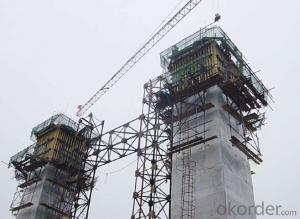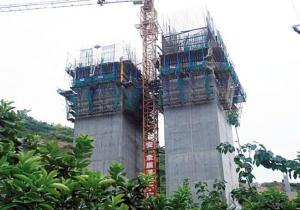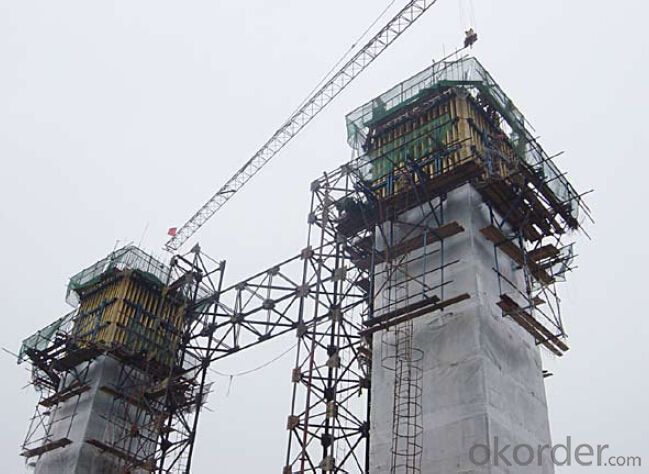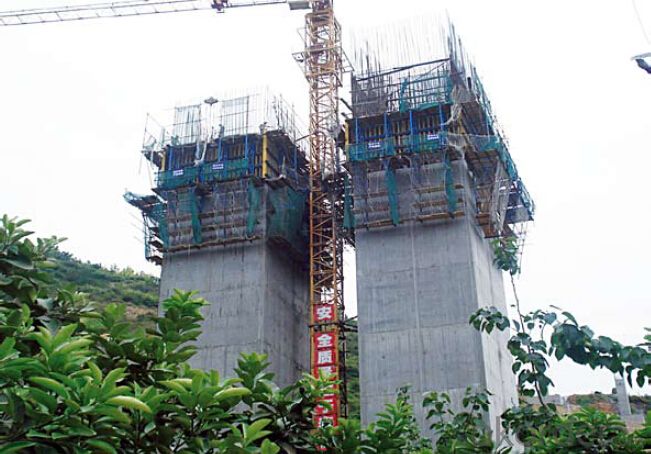Climbing Bracket for formwork and scaffolding system
- Loading Port:
- Tianjin
- Payment Terms:
- TT OR LC
- Min Order Qty:
- 50 m²
- Supply Capability:
- 1000 m²/month
OKorder Service Pledge
OKorder Financial Service
You Might Also Like
Climbing Bracket CB240 & CB210
They are framework brackets for supporting large-area wall formwork.
Typical applications for the CB240&CB210 are pier and column/shear wall/core walll/ in the
building.
CB210 has smaller size than CB240, it will be cost effective in some condition.
Characteristics:
◆ High bearing capacity
The high loading capacity of the brackets allow very large scaffold units. This saves the number
anchor points required as well as reducing climbing times.
◆ Simple moving procedure by crane
Through the strong connection of formwork together with the climbing scaffold, both can be moved
as a single climbing unit by crane. Thus valuable time-savings can be achieved.
◆ Fast striking process without a crane
With the retrusive set, large formwork elements can also be retracted quickly and a minimum of
effort.
◆ Safe with work platform
The platforms have assembled firmly with bracket and will be climbing together, without scaffolding
but can work safely in spite of your high location.
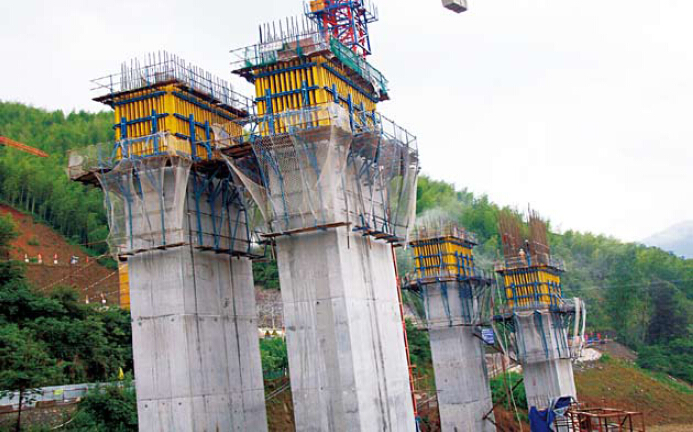
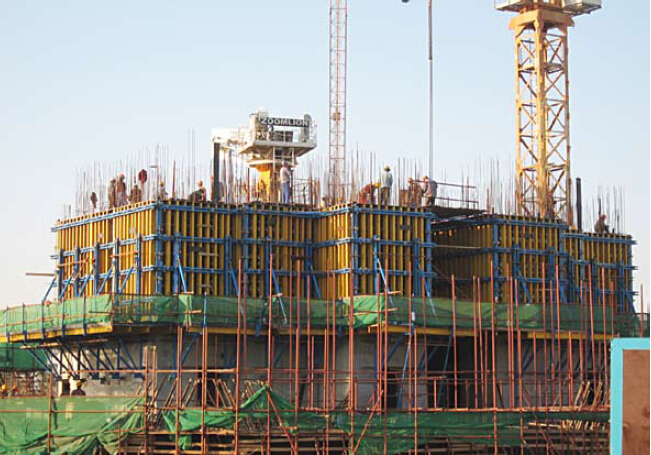
- Q: How does steel formwork handle concrete vibration during pouring?
- Steel formwork is a versatile and durable construction material that is commonly used in concrete pouring processes. When it comes to handling concrete vibration during pouring, steel formwork has several advantages. Firstly, steel formwork is known for its high strength and rigidity, which allows it to withstand the intense vibrations caused by the pouring of concrete. The robustness of steel formwork ensures that it remains stable and in place during the vibration process, preventing any potential deformation or collapse that could occur with weaker materials. Additionally, steel formwork is designed with interlocking systems and tight joints that help to minimize the potential for concrete leakage. This ensures that the concrete remains contained within the formwork, allowing for a more efficient pouring process and reducing the need for excessive clean-up or rework. Moreover, steel formwork is capable of transmitting vibrations efficiently throughout its structure. This is advantageous as the vibrations help to eliminate air bubbles and voids within the concrete, resulting in a more uniform and compact final product. The ability of steel formwork to effectively transmit vibrations aids in achieving a higher level of concrete compaction, which enhances the overall strength and durability of the structure. Lastly, steel formwork is highly reusable and can be easily disassembled and reused for multiple projects. This is advantageous in terms of cost-effectiveness and sustainability, as it reduces the need for constant replacement of formwork materials. The ability to reuse steel formwork also means that its effectiveness in handling concrete vibration remains consistent over time. Overall, steel formwork is a reliable and efficient material for handling concrete vibration during pouring. Its strength, stability, and ability to transmit vibrations make it a preferred choice in construction projects where concrete pouring and compaction are required.
- Q: What are the different material handling requirements for steel formwork?
- The different material handling requirements for steel formwork involve proper storage, lifting, transportation, and maintenance of the steel components. Steel formwork should be stored in a dry and secure area, away from moisture and exposure to the elements. When lifting, it is essential to use appropriate lifting equipment and follow proper rigging procedures to ensure the safety of workers and prevent damage to the formwork. During transportation, the steel formwork should be securely fastened and protected from any potential impacts or vibrations. Regular maintenance, including cleaning, inspection, and repair, is crucial to ensure the longevity and performance of the steel formwork.
- Q: How does steel formwork contribute to the overall moisture resistance of the structure?
- In several ways, steel formwork plays a role in the overall moisture resistance of a structure. Firstly, its design focuses on high durability and resistance to corrosion. This means that it can endure exposure to moisture without deteriorating or compromising its structural integrity. Moreover, tight joints and connections are used in the construction of steel formwork to minimize the possibility of water infiltration. Unlike traditional timber formwork, steel formwork does not shrink or warp when exposed to moisture, guaranteeing the absence of gaps or openings that would allow water to seep into the structure. In addition, protective finishes such as epoxy or galvanized coatings are often applied to steel formwork, providing an additional layer of moisture resistance. These coatings act as a barrier, preventing water from seeping into the steel and reaching the concrete structure. Steel formwork ensures that moisture is prevented from entering the structure by providing a robust and watertight enclosure during the construction process. This is especially crucial for structures that will face external elements, such as bridges or buildings located in humid or rainy climates. In summary, steel formwork's durability, tight joints, and protective coatings contribute to the overall moisture resistance of a structure, ensuring that it remains structurally sound and free from water damage.
- Q: I would like to ask the bridge column (D110) steel template thickness should be how much
- The bridge column (D110) column die steel template if the combination of the steel mold, the control panel in 3-5mm more appropriate, to determine the main force depends on the template and rib spacing, material selection.
- Q: What are the different types of formwork corner solutions used in steel formwork?
- There are several different types of formwork corner solutions used in steel formwork, including internal corners, external corners, chamfered corners, and rounded corners. Internal corners are used to create seamless and smooth transitions between walls or columns, while external corners are used to create sharp and precise edges. Chamfered corners are used to create angled or beveled edges, providing a more decorative finish to the concrete structure. Finally, rounded corners are used to create curved or rounded edges, adding a softer and more aesthetically pleasing look to the finished formwork.
- Q: What are the different types of form ties used in steel formwork systems?
- In steel formwork systems, there exist various form ties that serve to establish a secure bond between the formwork panels and supporting structures. 1. Conventional Form Ties: The most commonly employed form ties are those comprised of a steel rod with cones or washers on both ends. These rods are inserted through the formwork panels and secured using nuts or wedges, resulting in a robust connection. 2. Coil Ties: These ties are constructed from a continuous loop of wire, often galvanized to resist corrosion. They are simple to install and remove, and can accommodate different concrete wall thicknesses by adjusting the loop length. 3. She-Bolts: Alternatively referred to as she-bolts or coil bolts, these form ties consist of a threaded rod embedded in the concrete wall, along with a plate and nut on the external side. They establish a sturdy connection and find common usage in scenarios where frequent formwork removal and repositioning is necessary. 4. Snap Ties: Equipped with a flat plate on one end and a snap-tie wedge on the other, these ties are easily and swiftly installed without any special tools. They offer a dependable connection and are suitable for light to medium-duty applications. 5. Plastic Cone Ties: Designed for use with reusable plastic formwork systems, these ties are made from plastic material. They possess a lightweight nature, are easy to handle, and exhibit excellent resistance to chemical corrosion. 6. Flat Ties: Strip or bar-shaped, flat ties are utilized to connect formwork panels. Typically crafted from steel, they can be readily bent or cut to the desired length. These ties are frequently employed in scenarios where the wall thickness is minimal. 7. Wedge Bolts: Comprising a threaded rod, a wedge-shaped plate, and a nut, these form ties are inserted into a hole in the formwork panel. Tightening the nut secures the connection. Wedge bolts are commonly employed in situations requiring high strength and rapid installation. These aforementioned examples merely represent a selection of the various form ties adopted within steel formwork systems. The choice of form tie is contingent upon factors such as the application, concrete wall thickness, desired strength, and ease of installation and removal.
- Q: How is steel formwork assembled and disassembled?
- Steel formwork is typically assembled by connecting individual steel panels together using various types of locks or clamps. This allows for the creation of a sturdy and adjustable framework that can be tailored to the desired shape and size of the concrete structure. To disassemble, the locks or clamps are released, allowing the panels to be removed and repositioned for future use. This process is efficient, as steel formwork is reusable and can be easily dismantled, making it a cost-effective solution for construction projects.
- Q: Steel formwork in the construction project, after the completion of concrete pouring, the wall surface from the powder seriously how to deal with?
- Two possibilities, one is the vibration of concrete and other factors to produce concrete segregation; the two is the ratio of the concrete itself (see a similar situation, pumping agent over)
- Q: How does steel formwork contribute to improved construction quality?
- The utilization of steel sheets or panels in the construction technique known as steel formwork is widely acknowledged for its positive impact on construction quality. To begin with, the precision and accuracy offered by steel formwork in shaping concrete structures are noteworthy. The steel panels are precisely manufactured to ensure the desired specifications are met during the construction process. This level of accuracy minimizes the occurrence of errors and inconsistencies, resulting in a construction outcome of superior quality. Moreover, steel formwork exhibits exceptional durability and stability. Unlike traditional wooden formwork, steel formwork can withstand adverse weather conditions, heavy loads, and repeated use without warping or deforming. This durability guarantees the integrity of the formwork throughout the construction process, avoiding any potential issues that may arise from a compromised system. Additionally, steel formwork facilitates faster construction cycles compared to other formwork materials. The ease of assembly and disassembly, coupled with the ability to reuse the formwork on multiple projects, significantly reduces construction time. This efficiency not only saves time for construction companies but also minimizes disruptions to neighboring sites and reduces costs associated with extended construction periods. Furthermore, the use of steel formwork contributes to the enhancement of construction quality by providing a smooth and uniform finish to concrete structures. The seamless mold created by the steel panels eliminates the need for excessive remedial work such as plastering or patching. This results in a visually appealing and aesthetically pleasing final product, which is crucial for projects that require high-quality finishes. Additionally, steel formwork allows for greater flexibility in design and construction. The modular nature of the steel panels enables architects and engineers to effortlessly create complex and intricate structures. This versatility facilitates the construction of unique and innovative designs, ultimately enhancing the overall quality and visual appeal of the project. In conclusion, steel formwork plays a significant role in improving construction quality by offering high precision, durability, efficiency, and flexibility. Its ability to create accurate molds, withstand external forces, reduce construction time, and produce seamless finishes ensures that the final concrete structures meet the highest standards of quality and durability.
- Q: What are the different types of accessories used in steel formwork installation?
- There are several types of accessories used in steel formwork installation, each serving a specific purpose to ensure a successful construction process. Some common types of accessories include: 1. Wedges: These are used to secure the formwork panels in place and provide stability during concrete pouring. Wedges are inserted between the panels and tightened to hold them firmly in position. 2. Ties: Ties are essential for connecting the formwork panels together and maintaining the desired shape of the structure. They are typically made of steel and are used to prevent the panels from bulging or shifting during the pouring process. 3. Formwork clamps: These clamps are used to join the formwork components and secure them firmly in place. They are designed to withstand the pressure exerted by the wet concrete and hold the formwork system together. 4. Braces: Braces are used to provide additional support and stability to the formwork system. They help distribute the load evenly and prevent the panels from bending or collapsing under the weight of the concrete. 5. Scaffolding: Scaffolding is often used in conjunction with steel formwork installation to provide a safe working platform for workers. It allows them to access higher areas of the structure and perform various construction tasks. 6. Corner fillets: Corner fillets are used to create rounded corners in the formwork, ensuring a smooth finish and preventing sharp edges. They are made of flexible materials such as rubber or PVC and are easy to install and remove. 7. Formwork release agents: These agents are used to prevent the adhesion of concrete to the formwork surface. They create a thin barrier between the formwork and the concrete, allowing for easy removal of the formwork once the concrete has cured. 8. Formwork spacers: Spacers are used to maintain a consistent gap between the formwork and the reinforcement bars, ensuring proper concrete cover. They help prevent corrosion and enhance the structural integrity of the concrete. 9. Lifting accessories: Lifting accessories such as lifting eyes or lifting hooks are used to safely lift and move the formwork panels into position. They are designed to withstand the weight of the panels and provide a secure attachment point for cranes or other lifting equipment. These are just a few examples of the different types of accessories used in steel formwork installation. Each accessory plays a crucial role in ensuring the formwork system is sturdy, secure, and capable of withstanding the pressures of concrete pouring. It is important to choose the appropriate accessories based on the specific requirements of the construction project.
Send your message to us
Climbing Bracket for formwork and scaffolding system
- Loading Port:
- Tianjin
- Payment Terms:
- TT OR LC
- Min Order Qty:
- 50 m²
- Supply Capability:
- 1000 m²/month
OKorder Service Pledge
OKorder Financial Service
Similar products
Hot products
Hot Searches
